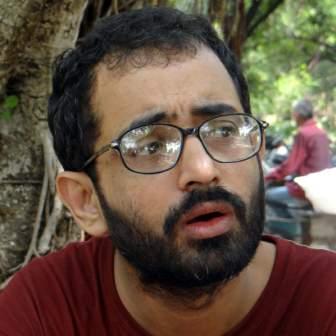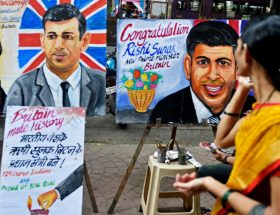Sanjeev Kumar and Babasaheb Kambale


It’s very rare to witness the demolition of any space of Brahminical importance – for instance, spaces associated with Gandhi, Nehru, Savarkar, and Patel etc. However, it’s very common that the spaces belonging to historical figures who propounded fraternity, equality, freedom and justice for humanity such as Ambedkar, Phule, Periyar, and Savitribai Phule etc., are being demolished both officially and unofficially. For instance, there was a reading room with a statue of Ambedkar adjacent to the Arts Faculty Library in Delhi University, where mostly economically weak students from all castes used to study. But both the reading room and the statue were demolished by university authorities to build a new building which is being allocated to the faculty of Law this year. It’s very unfortunate to observe that, it was Ambedkar, the most learned person in India when it comes to Law, whose statue was demolished and there was no reimbursement, whereas statues of Vivekananda, Nehru and Gandhi are protected by the Delhi University administration with care and respect. This is not only true of Delhi University, but it’s a pan Indian practice where Gandhi, Nehru family and Tagore’s spaces have become the most official sacred sites with the vibrancy of originality maintained, despite their losing relevance.
The most recent case of defiling the history and memory of dalit-bahujans happened in Dadar, Mumbai, last month. At 2 AM on 25th June 2016, Babasaheb Ambedkar’s Press and Bhawan was demolished. One can play devil’s advocate and say that, the state wants to build a multi-purpose multi-storey building in the memory of Babasaheb, thereby destruction was necessary. But if the state wanted to build a multi-floored building, construction of the same would have been welcomed, just not at the cost of destroying the existing heritage. That is the sheer mischief and collective conspiracy of the Trust’s authorities, and state mechanisms involved, to insult not only Ambedkarism, but the memory and history of Dalit-Bahujans. We have been to various places of Brahminical importance and found that they are never touched by the state whenever it wanted to convert the space into a heritage site; it was done by keeping the originality, history and memory of the space intact. But Ambedkar’s press and Bhavan was destroyed, this shows the maliciousness of the Brahminical attitude and the fear of Dalit-Bahujan history and space.

Figure 1: Picture Taken on 11-02-2015

Figure 2: Pictures after Demolition on 25- 06-2016
To appropriate Ambedkar’s house and other spaces has been a long awaited target of the governments, whether it was Shiv Sena, Congress, BJP or any other state or central parties in power. On 8th September 2015, The Hindu reported that “the last time a plan to convert Rajgriha into a memorial surfaced was in the 1990s under the Sudhakarrao Naik-led Congress government”. But the plan to convert could not materialise because Ambedkar’s descendants had to be reimbursed with alternate shelter in the same locality. Another argument is that, the effort to destroy the memory of Ambedkar is also a reply to Prakash Ambedkar’s critical approach towards the BJP. There is no doubt that the larger culprit is the present government whether it be in the state or the centre, but who is the stooge behind the immediate demolition?
The demolition could not have been proceeded if three officials of the ‘The People’s Improvement Trust’ (PIT, renamed in 2004) – Ratnakar Gaikwad, the Chief Information Commissioner, Government of Maharashtra and Advisor of the trust (PIT), Shrikant Gavare, Secretary of PIT and Madhukar Kamble had not been involved. Although, they hold the post of advisor and secretary of the trust, they are not trustworthy in any sense. They are the immediate culprits who collaborated with the state in the demolition conspiracy. Nonetheless, the ownership of the property and ancestral right of Ambedkar’s property is a legal matter which has not yet been resolved. Taking the ambiguousness of the status of the property and possessing the official position of the trust, Gaikwad, Gavare and Kamble found it easy to collaborate in the demolition.
These three figures have not shown any repentance and regret yet. Being the collaborators of the government, they are trying to justify the demolition of the space. In the program “Aajcha Sawal” on the television channel ‘Maharashtra 1’, on 27-06-2016, when it was asked why this historical place was attacked and demolished during the middle of the night, Gavare replied that the machine (printing press) was kept under the mud at the same place and the place has no historical or national heritage importance. Is there any Ambedkarite who can refuse to see Ambedkar Bhavan and the press as having no worth in Ambedkar’s history and memory? Such justification propagated by Gaikwad and his collaborators is false and unacceptable.
The historical facts have proved that the role of the state is always insidious in the Dalit movement, wherein some Dalit conspirators accompany the state in such anti-Ambedkarite moves. The Ambedkarite movement has suffered the most because of such middle class Dalit-Bahujans who have limited their activism to short term selfish gains. The 17 storey building could be attractive for the trustees’ but its modern nature would deny the poor Dalit easy access. In the Foucault’s terminology, Ambedkar Bhavan was functioning like ‘Heterotopia’. A public place with multiple spatial functions. The new structure will take the form of a gated community. Eventually it will lose its identity as an open public place and will become an emblem of elitism. The proposed multi-storey building would function as a heterotopia of consumption and pleasure for middle and affluent class. This class also includes a segment of Dalits.
The proposed 17-storey structure with multi-level parking and other facilities will be appropriated by the newly emerged middle class Dalit-Bahujans who have masked their faces in the name of their Dalit-Bahujan identity, while serving state agencies which have always been uncomfortable with Dalit-Bahujan public spaces. The moment the proposed building is completed and unveiled, poor Dalit-Bahujan masses will not be able to access the place, which would be an anti-Ambedkarite move and will be contradictory to Ambedkar’s intention to serve the poor masses from all castes.The Ambedkarite critique of the demolition is that if the state wants to construct something, let’s construct a new building in a new space, but the destruction of the memory and history of Ambedkar by demolishing Ambedkar Bhawan and press is not acceptable. The state could have endeavored to convert the Bhawan and press into a heritage site with better upkeep of the place, keeping its vibrancy and energy intact.
Ambedkarite Space and its Memory
‘The Bombay Scheduled Caste Improvement Trust’ (now renamed as PIT) was founded in the 29 July 1944 by Dr. B. R.Ambedkar. The aim of the Trust was ‘to build a community hall’ for the Dalit Community because there was no space in public for Depressed classes to organize festivals, marriages or any public ceremonies. There was no homeland for untouchables; the public spaces were Brahminical public spaces where entry of Dalits and untouchables was prohibited. The space has provided a sense of belonging and confidence of having an Ambedkarite space, which could be used by public without any discrimination, unlike Hindu temples and other Brahminical and expensive spaces, to organize personal and public ceremonies. That was the intention of Babasaheb behind opening the trust and the Bhawan. Eventually the center of the movement and social space of dalits was shifted from Daamodar Hall in Parel to the community hall at Dadar. During World War II, this place became the center for the Mahar Battalion. It was not a shelter for the Dalits alone, but refugees from India- Pakistan partition were also given shelter in the premises. The place has historic and contemporary importance for Dalit-Bahujans. It gives a sense of belonging and of the history of struggle, including where Babasaheb had laid the foundation of politics of print media for social and political awareness among the masses.
After his death, the space retained its Ambedkarite vibrancy. The structure and environment of this place remained a hub for the upcoming Dalit Panther movement. Ambedkarite literature and book stalls added magnetism to the historicity of the place. Nonetheless, the multipurpose hall was open to be used by all communities across castes and religions. It is a historic place in the sense that it witnessed all post-Ambedkar radical movements such as Dalit Panther, Namantar and Riddles Movement. The space was not confined to the Dalits but backward castes, religious minorities and women participated in it with a sense of fraternity and belonging. Most recently, Rohith Vemula’s mother Radhika Vemula and brother Raja Vemula embraced Buddhism at the same Bhavan.
Ambedkar wanted the place to be used for public purposes and not as the family’s inheritance, so he did not authorise his family members to claim property rights and left the administrative post open for circulation. The administrative positions of the trust have been circulating according to this convention, but the moment the administration of the trust came into the hands of middle class Dalits such as Gaikwad, Gavare and Kamble, it became harmful for the dalit Bahujan history, memory and movement.
Memorizing Visit to Rajgriha
Dontha Prashanth (one of the leading student activists who along with Rohith Vemula and other three students was suspended from the Hyderabad Central University hostel, and has been continuously struggling for Justice for Vemula and punishment for the culprits who forced him to commit suicide in February 2016), Bijaya Kumar Sethi (a Ph.D.scholar from Madhya Pradesh) and I (a Ph.D.scholar, working on Buddhist Conversion at Deekshabhumi, University of Delhi) had visited Dadar to participate in a national seminar organized by Babasaheb Kambale (Ph.D. scholar, History Department, Mumbai University) on 10th February 2015. Obviously, as any Ambedkarites, we were more curious to visit Babasaheb Ambedkar’s home (Rajgriha), his Printing Press and Chaitya Bhoomi.
We reached the printing press, on 11th February, 2015. Looking at the old machines (some functional and some taking their last breath), old issues of Prabuddha Bharat and paper cutting machines used by Babasaheb etc. gave us a deep sense of historical truth. We were touching things and trying to take pictures to keep them for our personal archives. Witnessing the aura of the place with its old structure and the fact of Babasaheb’s historic presence at the place, we started imagining how Babasaheb would have been working in this place and securing our existence and future rights. Buddhist philosophy, and even science suggests that the energy (both positive and negative) of a place and person stays around; if someone goes deeper in the level of feeling and connects one’s self and energy with the existing aura, then s/he may receive similar energy of the place which prevails spatio-temporally around. We were observing and feeling machines and old deteriorating issues of Prabuddha Bharat, as if a child is looking at the possessions of grandparents whom s/he has never met but tries to know more and feel more about. We really went deeper and back to the time of Babasaheb by observing the old artifacts of the heritage site that gave us a different confidence and higher energy to ‘become our own Babasaheb’. Such a feeling and aura of Babasaheb will never be experienced by the coming generations of Dalit-Bahujans after the barbaric demolition of the space.

Figure 3: Witnessing Humiliation of Ambedkar by Local Brahman: 11-02-2015 at Rajgriha
The same day at Rajgriha, standing outside and looking at the house, Dontha Prashanth experienced how caste continues to prevail and the house of Ambedkar irritates Chitapavan Brahmans in that locality. Prashanth updated his Facebook status to say that, “on 11/02/2015, I was on a visit to Rajgriha, Mumbai. Given the personal memories of Ambedkar remaining in visible form, visiting such a place would be exciting for every dalit. I too was watching at Rajgriha with utmost happiness. Suddenly, an Individual standing in front of Rajgriha, with his two dogs asked with contempt, “Kyaa Dekh rahe ho (what are you looking at)?” surprised at the nature of his question, i replied “I’m looking at Rajgriha, a memory of Babasaheb”. Then the man ridiculed Prashanth by saying,”Are u watching at United States of America, or what?” The sentiment of hatred and discomfort with Ambedkar’s house, statues, ideas and concerns of justice for humanity are not only prevalent in the minds of Brahminical people, but this has a spatio-temporal continuity in the recent times as well.
What do these public and personal experiences reflect? First, although Dalit-Bahujans have struggled against social and political evils whose history has not been fully recorded, the Brahmanical history of domination has become the official and pedagogical common sense in the public. Whatever historical evidences, places, memories we have are not tolerated by the society and the state, and a continuous effort is on to annihilate the history and memory of Ambedkarism. Secondly, certain Dalit-Bahujan middle class sections are also participating in such conspiracies,and Ambedkarism needs to be alert about them. Thirdly, the existing leadership of the Dalit-Bahujans needs to be put on trial. Finally, until and unless a new intellectually, socially and politically active Ambedkarism is not educated, organized and agitated in India, the Brahaminical forces in collaboration with state mechanisms will keep destroying the memory and history of Ambedkarism in the name of sanitization of Ambedkarite spaces.
We would like to extend our sincere thanks to Jayashree Kamble, Assistant Professor, English, LaGuardia Community College, New York, for her valuable suggestions.
~~~
Sanjeev Kumar is Assistant Professor, SPM College, University of Delhi; he can be contacted at: sanjeev.spmcollege@gmail.com
Babasaheb Kambale is a PhD Candidate at University of Mumbai; his email id is: babasaheb82@gmail.com










